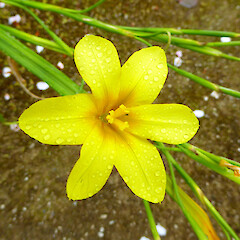Moraea flaccida
Common name
Cape tulip
Synonyms
Homeria collina (of NZ and Australian authors) - for many years Moraea flaccida in NZ and Australia has been misidentified as Homeria (or Moraea) collina
Family
Iridaceae
Flora category
Vascular – Exotic
Structural class
Herbs - Monocots
Conservation status
Not applicable
Brief description
A single glabrous leaf arises from a corm; flowering stem usually branched with green bracts near the top of the stem. Flowers with 6 orange-salmon-pink or yellow tepals, 4-5 cm diameter.
Habitat
Terrestrial. Pasture and grassy waste land in scattered localities.
Detailed description
The plant grows up from a globose corm which has a thick, fibrous tunic. Two or three long, tough leaves arise at the base of the stem, arching over to trail their tips on the soil. Flowers funnel-shaped, about 5cm diameter, usually orange or salmon pink with a yellow centre, but occasionally be entirely yellow with a slightly darker centre. The stem has a characteristic “zig zag” shape, with the flowers borne at the angles. Numerous seeds are produced in a narrow, cylindrical capsule 4 to 5cm long x 5mm. Numerous corms are also produced, ranging in size form the size on a wheat grain up to 2.5 cm in diameter (DOC 1998).
Similar taxa
Distinguished by the long solitary tough leaf (Healy and Edgar 1980).
Flowering
September, October, November
Flower colours
Orange, Red/Pink
Life cycle
Perennial. Listed as a class A noxious weed, but more because it is toxic than for any environmental impacts in NZ (Ewen Cameron 1996). Reproduces by corms and seeds (3000-6000 per plant). Seeds spread by wind, corms and seeds spread by water, and on mud spread by animals, implements and vehicles.
Year naturalised
1944
Origin
South africa
Reason for introduction
Ornamental
National Pest Plant Accord species
This plant is listed in the 2020 National Pest Plant Accord. The National Pest Plant Accord (NPPA) is an agreement to prevent the sale and/or distribution of specified pest plants where either formal or casual horticultural trade is the most significant way of spreading the plant in New Zealand. For up to date information and an electronic copy of the 2020 Pest Plant Accord manual (including plant information and images) visit the MPI website.


